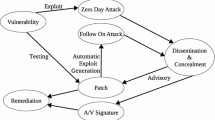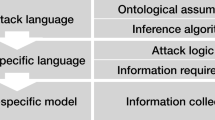Abstract
A Trojan malicious code is one of largest malicious codes and has been known as a virus that causes damage to a system as itself. However, it has been changed as a type that picks user information out stealthily through a backdoor method, and worms or viruses, which represent a characteristic of the Trojan malicious code, have recently been increased. Although several modeling methods for analyzing the diffusion characteristics of worms have proposed, it allows a macroscopic analysis only and shows limitations in estimating specific viruses and malicious codes. Thus, in this study an EMP model that can estimate future occurrences of Trojan malicious codes using the previous Trojan data is proposed. It is verified that the estimated value obtained using the proposed model is similar to the existing actual frequency in causes of the comparison between the obtained value and the result obtained by the Markov chain.











Similar content being viewed by others
References
Zou, C. C., Gong, W., & Towsley, D. (2002). Code red worm propagation modeling and analysis. In Conferrence on computer and communications security.
Jun, Y. T., Moon, J. S., & Seo, J. T. (2007). A study of worm propagation modeling extended AAWP, LAAWP modeling. Journal of Information Security and Cryptology, 17(5), 73–86.
Cohen, F. B. (1992). A formal definition of computer worms and some related results. Computer & Security, 7(11), 641–652.
Gleissner, W. (1989). A mathematical theory for the spread of computer viruses. Computer & Security, 8(1), 35–41.
Wangner, A., Dubendorfer, T., & Plattner, B. & Hiestand, R. (2003) Experiences with worm propagation simulations. In Proceedings of the 2003 ACM workshop on Rapid malcode, pp. 34–41
Yang, W. & Chenxi, W. (2003). Modeling the effects of timing parameters on virus propagation. In Proceedings of the 2003 ACM workshop on Rapid malcode, pp. 61–66.
Hak-Yong, H. (2009). Pattern recognition surveying (pp. 432–438). HanbitMedea.
Park, W. H., Kim, Y. J., Lee, D. H., & Kim, K. J. (2008). A study on prediction of mass SQL injection worm propagation. Journal of Information and Security, 8(4), 173–181.
Farrington, D. P., Martin, G., Waples, S. J., & Argomaniz, J. (2007). The effects of closed-circuit television on crime: Meta-analysis of an English national quasi-experimental multi-site evaluation. Journal of Experimental Criminology, 3(1), 21–38.
Symantec. (2011). Symantec internet security threat report trends for 2010 (Vol. 16).
AhnLab. (2013) ASEC REPORT, Annual report.
Acknowledgments
This work was supported by Kyonggi University Research Grant 2013.
Author information
Authors and Affiliations
Corresponding author
Rights and permissions
About this article
Cite this article
Kim, K.J., Kim, J. A Study on the Markov Chain Based Malicious Code Threat Estimation Model. Wireless Pers Commun 94, 315–329 (2017). https://doi.org/10.1007/s11277-015-3018-6
Published:
Issue Date:
DOI: https://doi.org/10.1007/s11277-015-3018-6




